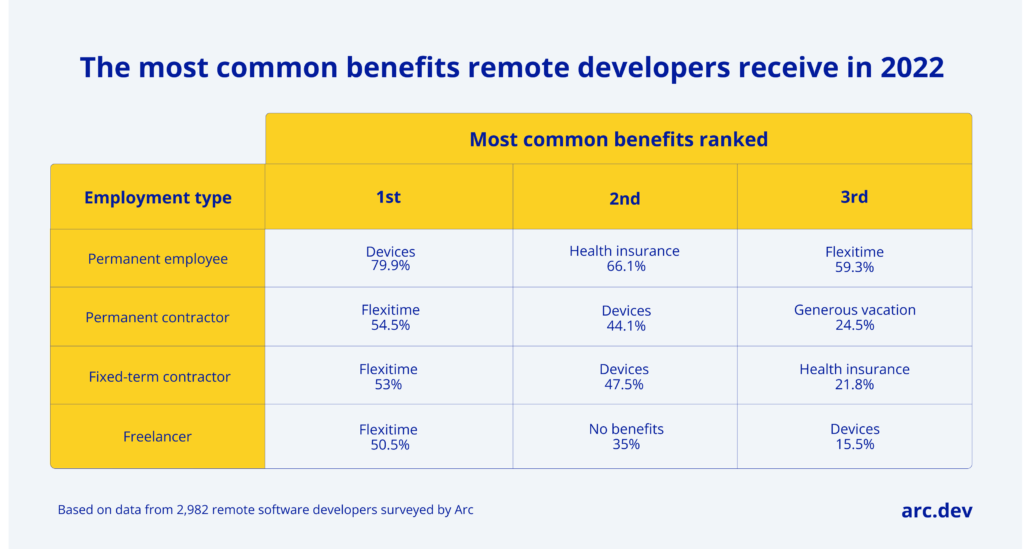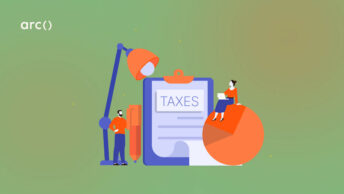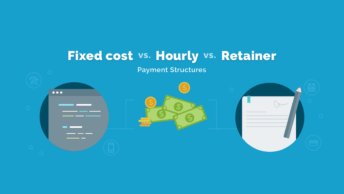The most common benefits offered to remote software developers are devices, flexible working hours, and health insurance.
The results are based on a survey of 2,982 remote software developers from over 100 countries, including the US, Canada, UK, Germany, Spain, Argentina, Brazil, Mexico, India, Pakistan, Australia, South Africa, and more. The developers work remotely or in a hybrid organization.
Some remote developers also reported receiving an emerging benefit: English classes.
Looking to hire the best remote talent? See how Arc can help you:
⚡️ Find the world’s top developers, designers, and marketers
⚡️ Hire 4x faster with fully vetted candidates
⚡️ Save up to 58% with global hires
Hire top talent with Arc risk-free →
The top benefits offered to developers
The data below provides the state of the benefits market to assist human resources professionals in making informed decisions. The top benefits that remote software developers receive, across all employment types, are:
- Devices 65.8%,
- Flexible working hours 57%,
- Health insurance 47.6%,
- Learning stipend 33.6%.
- Companies also address employees’ wish for work-life balance and more time to spend with their families by offering maternity/paternity leave to 28.1% — and generous vacation to 24.1% — of remote developers.

The top benefits by employee type
The benefits package differs based on types of employment:
- Full-time permanent employees: They are the highest percentage to receive health insurance at 66.1%.
- Full-time permanent contractors: This category of developers is becoming more common as companies look for full-time permanent roles internationally in countries where they cannot legally hire employees. 24.5% receive generous vacations — a perk unique to these developers in the top 3.
- Fixed-term contractors: Some full-time and part-time fixed-term software developer contractors also receive devices (47.5%) and health insurance (21.8%).
- Freelancers: They get the least benefits — with 35% getting no benefits at all.

Out-of-box benefits
The tech industry has seen the hottest job market since the dot com era. So employers are thinking outside the box to attract and retain software developers during the Great Resignation.
Offering English classes is one of the lesser-known — but useful — perks that is increasingly available to developers. Multiple developers surveyed from Latin America and Spain reported receiving this benefit. As more and more companies hire globally, English remains an in-demand skill in the workplace for communication. For remote developers, English skills open up international opportunities not available before.
Other reported benefits include LinkedIn Learning, as well as a company car, bicycle leasing, clothes, and food money — carrying over from the pre-pandemic era.
Conclusion
Employers have added to or extended their benefits in the last six months to counter a hot hiring market. If you are thinking of revising your benefits too, this report can serve as a benchmark. Devices, flexitime, and health insurance are the most common benefits that remote developers receive.
You can also try Arc, your shortcut to the world’s best remote talent:
⚡️ Access 350,000 top developers, designers, and marketers
⚡️ Vetted and ready to interview
⚡️ Freelance or full-time
Try Arc and hire top talent now →
Data source
The data was collected from December 31, 2021, to March 9, 2022, via an ongoing online survey. The results from the survey are updated in real-time in the Remote Developer Salary Database here.
The report is based on answers from 2,982 software developers working remotely or for hybrid organizations.
Percentage of entries by employment status:
- Full-time permanent employee (with benefits): 61.6%
- Full-time permanent contractor: 14.8%
- Fixed-term contractor (both part-time and full-time): 20.2%
- Freelancing: 3.5%








